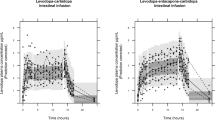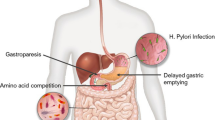Abstract
This paper reviews the clinically relevant determinants of levodopa peripheral pharmacokinetics and main observed changes in the levodopa concentration–effect relationship with Parkinson’s disease (PD) progression. Available clinically practical strategies to optimise levodopa pharmacokinetics and pharmacodynamics are briefly discussed. Levodopa shows particular pharmacokinetics including an extensive presystemic metabolism, overcome by the combined use of extracerebral inhibitors of the enzyme l-amino acid decarboxylase and rapid absorption in the proximal small bowel by a saturable facilitated transport system shared with other large neutral amino acids. Drug transport from plasma to the brain is mediated by the same carriers operating in the intestinal mucosa. The main strategies to assure reproducibility of both intestinal absorption and delivery to the brain, and the clinical effect include standardization of levodopa dosing with respect to meal times and a controlled dietary protein intake. Levodopa plasma half-life is very short, resulting in marked plasma drug concentration fluctuations which are matched, as the disease progresses, to swings in the therapeutic response (“wearing-off” phenomena). “Wearing-off” phenomena can also be associated, at the more advanced disease stages, with a “negative”, both parkinsonism-exacerbating and dyskinetic effect of levodopa at low, subtherapeutic plasma concentrations. Dyskinesias may also be related to high-levodopa, excessive plasma concentrations. Recognition of the different levodopa toxic response patterns can be difficult on a clinical basis alone and simultaneous monitoring of the levodopa concentration–effect relationship may prove useful to disclose the underlying mechanism and in planning the correct management. Clinically practical strategies to optimise levodopa pharmacokinetics, and possibly its therapeutic response, include liquid drug solutions, controlled release formulations and the use of inhibitors of levodopa metabolism. Unfortunately, these attempts have proved so far only partly successful, due to the complex alterations in cerebral levodopa kinetics which accompany the progressive degeneration of the nigrostriatal dopaminergic system in PD patients.




Similar content being viewed by others
References
Astarloa R, Mena MA, Sanchez V, de la Vega L, de Yebenes JG (1992) Clinical pharmacokinetic effects of a diet rich of insoluble fiber on Parkinson disease. Clin Neuropharmacol 15:375–380
Baruzzi A, Contin M, Riva R, Procaccianti G, Albani F, Tonello C, Zoni E, Martinelli P (1987) Influence of meal ingestion time on pharmacokinetics of orally administered levodopa in Parkinsonian patients. Clin Neuropharmacol 10:527–537
Carter JH, Nutt JG, Woodward WR (1992) The effect of exercise on levodopa absorption. Neurology 2:2042–2045
Cedarbaum JM (1989) The promise and limitations of controlled-release oral levodopa administration. Clin Neuropharmacol 12:147–166
Committee on Dietary Allowances Food and Nutrition Board (ed) (1989) Recommended dietary allowances. National Academy Press, Washington, DC
Contin M, Riva R, Martinelli P, Procaccianti G, Cortelli P, Avoni P, Baruzzi A (1990) Response to a standard oral levodopa test in Parkinsonian patients with and without motor fluctuations. Clin Neuropharmacol 13:19–28
Contin M, Riva R, Martinelli P, Procaccianti G, Albani F, Baruzzi A (1991) Combined levodopa-anticholinergic therapy in the treatment of Parkinson’s disease: effect on levodopa bioavailability. Clin Neuropharmacol 14:148–155
Contin M, Riva R, Martinelli P, Albani F, Baruzzi A (1991) Effect of age on the pharmacokinetics of oral levodopa in patients with Parkinson’s disease. Eur J Clin Pharmacol 41:463–466
Contin M, Riva R, Martinelli P, Baruzzi A (1992) Kinetic–dynamic relationship of oral levodopa: possible biphasic response after sequential doses in Parkinson’s disease. Mov Disord 7:244–248
Contin M, Riva R, Martinelli P, Cortelli P, Albani F, Baruzzi A (1993) Pharmacodynamic modeling of oral levodopa: clinical application in Parkinson’s disease. Neurology 43:367–371
Contin M, Riva R, Martinelli P, Cortelli P, Albani F, Baruzzi A (1994) Longitudinal monitoring of the levodopa concentration–effect relationship in Parkinson’s disease. Neurology 44:1287–1292
Contin M, Riva R, Martinelli P, Triggs EJ, Albani F, Baruzzi A (1996) The rate of motor response to oral levodopa and the clinical progression of Parkinson’s disease. Neurology 46:1055–1058
Contin M, Riva R, Albani F, Baruzzi A (1996) Pharmacokinetic optimisation in the treatment of Parkinson’s disease. Clin Pharmacokinet 30:463–481
Contin M, Riva R, Martinelli P, Cortelli P, Albani F, Baruzzi A (1999) Concentration–effect relationship of levodopa-benserazide dispersible formulation versus standard form in the treatment of complicated motor response fluctuations in Parkinson’s disease. Clin Neuropharmacol 22:351–355
Contin M, Riva R, Martinelli P, Albani F, Avoni A, Baruzzi A (2001) Levodopa therapy monitoring in patients with Parkinson disease: a kinetic–dynamic approach. Ther Drug Monit 23:621–629
Contin M, Martinelli P, Scaglione C, Avoni P, Albani F, Riva R, Baruzzi A (2008) The effect of entacapone on levodopa rate of absorption and latency to motor response in patients with Parkinson disease. Clin Neuropharmacol 31:267–271
Deleu D, Jacob P, Chand P, Sarre S, Colwell A (2006) Effects of caffeine on levodopa pharmacokinetics and pharmacodynamics in Parkinson disease. Neurology 12:897–898
Dingemanse J, Jorga K, Zurcher G, Schmitt M, Sedek G, Da Prada M, Van Brummelen P (1995) Pharmacokinetic–pharmacodynamic interaction between the COMT inhibitor tolcapone and single-dose levodopa. Br J Clin Pharmacol 40:253–262
Fabbrini G, Juncos JL, Mouradian MM, Serrati C, Chase TN (1987) Levodopa pharmacokinetic mechanisms and motor fluctuations in Parkinson’s disease. Ann Neurol 21:370–376
Fabbrini G, Mouradian MM, Juncos JL, Schlegel J, Mohr E, Chase TN (1988) Motor fluctuations in Parkinson’s disease: central pathophysiological mechanisms, part I. Ann Neurol 24:366–371
Gancher ST, Nutt JG, Woodward WR (1987) Peripheral pharmacokinetics of levodopa in untreated, stable and fluctuating Parkinsonian patients. Neurology 37:940–944
Guldberg HC, Marsden CA (1975) Catechol-O-methyl transferase: pharmacological aspects and physiological role. Pharmacol Rev 27:135–206
Guttman M, Leger G, Cedarbaum JM, Reches A, Woodward W, Evans A, Diksic M, Gjedde A (1992) 3-O-methyldopa administration does not alter fluorodopa transport into the brain. Ann Neurol 31:638–643
Harder S, Baas H, Rietbrock S (1995) Concentration–effect relationship of levodopa in patients with Parkinson’s disease. Clin Pharmacokinet 29:243–256
Harder S, Baas H, Bergemann N, Demisch L, Rietbrock S (1995) Concentration–effect relationship of levodopa in patients with Parkinson’s disease after oral administration of an immediate release and a controlled release formulation. Br J Clin Pharmacol 39:39–44
Juncos JL, Fabbrini G, Mouradian MM, Serrati C, Chase TN (1987) Dietary influences on the antiparkinsonian response to levodopa. Arch Neurol 44:1003–1005
Kaakkola S (2000) Clinical pharmacology, therapeutic use and potential of COMT inhibitors in Parkinson’s disease. Drugs 59:1233–1250
Kish SJ, Shannak K, Hornykiewicz O (1988) Uneven pattern of dopamine loss in the striatum of patients with idiopathic Parkinson’s disease: pathophysiologic and clinical implications. N Engl J Med 318:876–881
Kompoliti K, Adler CH, Raman MS, Pincus JH, Leibowitz MT, Ferry JJ, Blasucci L, Caviness JN, Leurgans S, Chase WM, Yones LC, Tan E, Carvey P, Goetz CG (2002) Gender and pramipexole effects on levodopa pharmacokinetics and pharmacodynamics. Neurology 58:1418–1422
Kurlan R, Nutt JG, Woodward WR, Rothfield K, Lichter D, Miller C, Carter JH, Shoulson I (1988) Duodenal and gastric delivery of levodopa in Parkinsonism. Ann Neurol 23:589–595
Leenders KL, Poewe WH, Palmer AJ, Brenton DP, Frackowiak RS (1986) Inhibition of l-(18F) fluorodopa uptake into human brain by amino acids demonstrated by positron emission tomography. Ann Neurol 20:258–262
Martinelli P, Contin M, Scaglione C, Riva R, Albani F, Baruzzi A (2003) Levodopa pharmacokinetics and dyskinesias: are there sex-related differences? Neurol Sci 24:192–193
Morgan JP, Rivera-Calimlim L, Messiha F, Sundaresan PR, Trabert N (1975) Imipramine-mediated interference with levodopa absorption from the gastrointestinal tract in man. Neurology 25:1029–1034
Muhlack S, Welnic J, Woitalla D, Muller T (2007) Exercise improves efficacy of levodopa in patients with Parkinson’s disease. Mov Disord 15:427–430
Nutt JG, Fellman JH (1984) Pharmacokinetics of levodopa. Clin Neuropharmacol 7:35–49
Nutt JG, Woodward WR, Hammerstad JP, Carter JH, Anderson JL (1984) The “on-off” phenomenon in Parkinson’s disease. Relation to levodopa absorption and transport. N Engl J Med 310:483–488
Nutt JG, Woodward WR (1986) Levodopa pharmacokinetics and pharmacodynamics in fluctuating parkinsonian patients. Neurology 36:739–744
Nutt JG (1987) On–off phenomenon: relation to levodopa pharmacokinetics and pharmacodynamics. Ann Neurol 22:535–540
Nutt JG, Woodward WR, Gancher ST, Merrick D (1987) 3-O-methyldopa and the response to levodopa in Parkinson’s disease. Ann Neurol 21:584–588
Nutt JG, Gancher ST, Woodward WR (1988) Does an inhibitory action of levodopa contribute to motor fluctuations? Neurology 38:1553–1557
Nutt JG (1990) Levodopa-induced dyskinesia: review, observations, and speculations. Neurology 40:340–345
Nutt JG, Holford NHG (1996) The response to levodopa in Parkinson’s disease: imposing pharmacological law and order. Ann Neurol 39:561–573
Nutt JG, Carter JH, Lea ES, Sexton GJ (2002) Evolution of the response to levodopa during the first 4 years of therapy. Ann Neurol 51:686–693
Nyholm D (2006) Pharmacokinetic optimisation in the treatment of Parkinson ‘s Disease. An update. Clin Pharmacokinet 45:109–136
Paalzow GHM, Paalzow LK (1986) l-dopa: how it may exacerbate parkinsonian symptoms. TIPS 9:15–19
Pierantozzi M, Pietroiusti A, Brusa L, Galati S, Stefani A, Lunardi G, Fedele E, Sancesario G, Bernardi G, Bergamaschi A, Magrini A, Stanzione P, Galante A (2006) Helicobacter pylori eradication and l-dopa absorption in patients with PD and motor fluctuations. Neurology 66:1824–1829
Quinn N, Parkes D, Marsden CD (1984) Control of on/off phenomenon by continuous intravenous infusion of levodopa. Neurology 34:1131–1136
Reuter I, Harder S, Engelhardt M, Baas H (2000) The effect of exercise on pharmacokinetics and pharmacodynamics of levodopa. Mov Disord 15:862–868
Rivera-Calimlim L, Dujovne CA, Morgan JP, Lasagna L, Bianchine JR (1970) l-dopa treatment failure: explanation and correction. Br Med J 4:93–94
Sage JI, Schuh L, Heikkila RE, Duvoisin RC (1988) Continuous duodenal infusions of levodopa: plasma concentrations and motor fluctuations in Parkinson’s disease. Clin Neuropharmacol 11:36–44
Vingerhoets FJ, Snow BJ, Lee CS, Schulzer M, Mak E, Calne DB (1994) Longitudinal fluorodopa positron emission tomographic studies of the evolution of idiopathic parkinsonism. Ann Neurol 36:759–764
Acknowledgments
The authors reused part of the content of a their previously published article [13], with permission from Adis, a Wolter Kluwer business (©Adis Data Information BV. 1996. All rights reserved).
Conflict of interest
There is no conflict of interest to declare.
Author information
Authors and Affiliations
Corresponding author
Rights and permissions
About this article
Cite this article
Contin, M., Martinelli, P. Pharmacokinetics of levodopa. J Neurol 257 (Suppl 2), 253–261 (2010). https://doi.org/10.1007/s00415-010-5728-8
Published:
Issue Date:
DOI: https://doi.org/10.1007/s00415-010-5728-8




